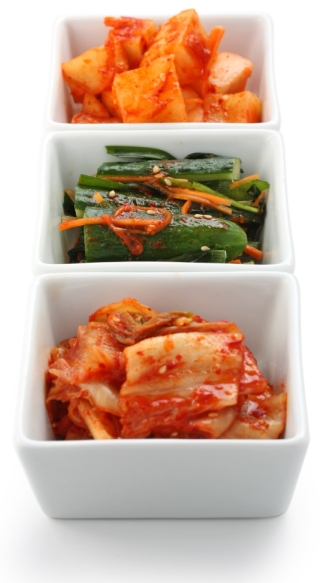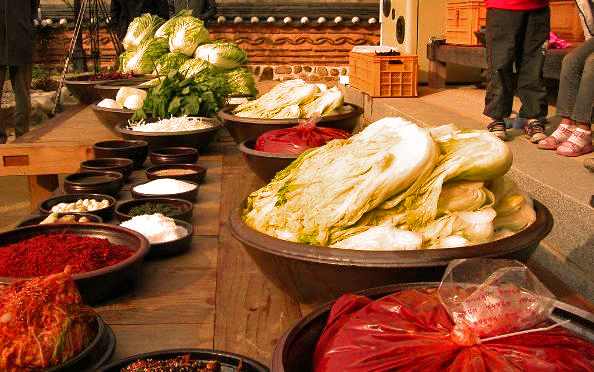 Kimchi is a fascinating thing. It is a salt-pickled Korean vegetable dish often made primarily of Napa cabbage, but also made of radish, cucumbers, spring onions and a wide variety of additional ingredients that create a range of flavor from spicy and hot to savory to mild and slightly sweet. Currently, there are over one hundred different varieties of kimchi and countless derivative dishes – from pancakes, omelets, and soups, to salads and stir fries and noodle dishes. Additionally, there are forms eaten in times past that are not commonly enjoyed anymore.
Kimchi is a fascinating thing. It is a salt-pickled Korean vegetable dish often made primarily of Napa cabbage, but also made of radish, cucumbers, spring onions and a wide variety of additional ingredients that create a range of flavor from spicy and hot to savory to mild and slightly sweet. Currently, there are over one hundred different varieties of kimchi and countless derivative dishes – from pancakes, omelets, and soups, to salads and stir fries and noodle dishes. Additionally, there are forms eaten in times past that are not commonly enjoyed anymore.
Interestingly, most of the kimchi encountered in the west is of the spicy and hot variety, and its slang use in English reflects this. We say we are in “deep kimchi” when we have troubles at work or in our personal lives. People (often women) with fiery or violent social reactions are often said to have “kimchi tempers”.
Unfortunately, some of this slang use of the word kimchi is used as derogatory to Asians. The term “kimchi squat” is often used described the way many Asians sit with knees bent and feet flat on the floor, or “kimchi handshake” to describe the rapid, light handshake that is common (and not-well liked by westerners) in many parts of Asia. Despite all that unpleasantness, kimchi isn’t always hot or spicy and varies quite a bit in flavor by where and how it is produced, the season of year it is made and how it is enjoyed once created.
Probably arising from Chinese suan cai a salted and fermented cabbage, kimchi started being produced in Korea during that country’s Three Kingdoms Period (57 – 668 ACE) and was made from vegetables soaked in beef broth and salt alone. The now distinctive red chili peppers, originating in the Americas were added only in the 16th Century after they were introduced into Korea by the Japanese after the Hideyoshi Invasions.
In general, kimchi made in the north is less salty and spicy than that produced in the south. Often, kimchi produced in Northern coastal areas is flavored with fresh fish, shellfish and oysters, and kimchi from southern coastal areas uses salted fish or brined anchovies or shellfish to flavor savory kimchi varieties. In the middle parts of the peninsula there is a wide variation in the types of kimchis produced, and it is characteristic of production in the middle east to bury or ferment the kimchi for longer periods – lending a stronger flavor to the final product.
Although modern technology has obviated the need for kimchi production in strict accordance to the availability of seasonal vegetables, Koreans still tend to produce and eat kimchi according to seasonal tradition. The biggest kimchi producing season of the year is late autumn or early winter after the harvest has come in. Women will often get together to make kimchi together at this time – so, once again, it takes a village to make great kimchi. Salted Napa cabbage is a popular center for the kimchi and this is often supplemented by Korean radish, parsley or cilantro, and ground red chili peppers. There are also some varieties that use little or no chili peppers and these varieties are known as white kimchi or water kimchi. In the middle part of the peninsula, it is also common to use pumpkin, squash or carrots as the kimchi center, although leeks and turnips are also used sometimes.

In the spring and summer, vegetables are pickled as they are harvested from the garden, often with lots of potherbs such as spinach, chard and fiddlehead ferns as well as other leafy greens used to flavor the kimchi of young radishes, cucumbers and early carrots etc. Kimchi made at this time is usually consumed quickly and not left to ferment for long periods of time, and so usually it has a milder flavor.
In the autumn, saltier, more savory or fishy varieties are commonly produced and enjoyed, with Napa cabbage being the most common center, although many other vegetables are also used.
This past weekend I put up several different types of Napa cabbage Kimchi, some spicy, some sweet, some savory and some a bit fishy. I like the mild chili peppers now known as Korean chilis so all of my types had red chili pepper flakes in the paste, but I also used Korean radish in some, fermented shrimp and anchovies in the savory and fishy types and in what I think may be original variations.
Despite its reputation, making kimchi is really rather simple. Although it is somewhat messy and time consuming, it is well worth the effort if you are a fan of the dish as I am. One of the things I like best about homemade kimchi is that it has much less salt than the average commercial product – which burns my mouth. I also like having different types of kimchi around so I can serve or enjoy spicy, sweet, or savory varieties – most of which are unavailable on the western consumer market.
Basic Napa Cabbage Kimchi (with variations)
Main Ingredients
1-2 large Napa cabbage
3/4 cup coarse sea salt
3-4 generous tablespoons garlic, peeled and minced (about 1 medium-large head)
2 generous tablespoons ginger, peeled and grated
1/3 – 1/2 cup Korean red pepper flakes
3 spring onions, thinly sliced
1/2 Korean radish, peeled and grated or thinly sliced
1-2 tablespoons sugar
1-2 tablespoons salt
Secondary flavors (optional)
2 carrots, peeled and thinly sliced
1 1/2 -2 tablespoons fermented shrimp
1 1/2 -2 tablespoons salted anchovies
Directions
Slice the cabbage in half and rinse well, especially in-between the leaves. Reserving a tablespoon or two of the salt to use in the chili paste, salt each of the leaves of the cabbage, dividing the salt between the cabbages, and place in a large vessel. Fill the vessel with water so that it covers about 1/3 of the cabbage. Cover or place a plate on top of the cabbage to keep most of it submerged and set aside. Flip the cabbages after about an hour so that both sides are submerged for some time. Total brining time should be 2-3 hours, but it is possible to brine overnight if desired.
When the brining is done, the cabbage should be supple, almost as if it had been parboiled. Drain the cabbage, and rinse twice in fresh water to remove excess salt. Shake or spin cabbage to remove excess liquid and set aside.
Place the garlic, ginger, red pepper, spring onions, radish, sugar, and salt into a large mixing bowl and mix well. Take time to adjust the flavor of the paste. If you like sweet kimchi, add a bit more sugar; if you like hot kimchi add a bit more red pepper. If using fermented shrimp or secondary vegetables like carrots, add them now. If using salted anchovies, give them a whirl in the food processor or mince finely before adding to the paste. When mixed and flavored to your satisfaction, cover and set aside for about 1/2 hour or until liquid has formed around the vegetables in the bowl. Mix again and let rest for about 15 minutes.
Add the cabbage – one bunch at a time – and work the paste all around each leaf until the leaves are evenly coated on both top and bottom. When you are done coating the leaves of each quarter, slightly run your fingers down the leaves and remove excess paste on the leaves. It is important to leave some, but not too much on each leaf. If desired, place each bunch on a cutting board and cut the base of the bunch to separate the leaves.
When you have a stack that you can easily handle, slide it into the jar. Then layer the next set of leaves with the flavor and stack those into the jar, pressing down as you fill the jar. When you fill the jar, cover and seal and rinse the outside of the lid and jar. Set aside in room temperature for 24 hours to get the fermentation going, then refrigerate to control the ferment. I put my jars on a plastic tray to catch any overflow and save cleaning the fridge too often. If there is any paste left, you can bottle this separately and nosh on it until the kimchi is ready.
I usually let my kimchi slowly ferment in the refrigerator for several days to a week before cracking a jar. Turn the jars upside down and then right them every few days before opening to allow even distribution of the spices and resulting liquid throughout the kimchi.
Kimchi is really quite delicious and healthy – containing lactobacillus, and lots of vitamins A and C, good quantities of iron and some of the B vitamins as well. It also really works well as a central flavor for a meal as in a kimchi soup or omelet, or simply as one of several banchan on bountiful Korean table. ((Words and recipe by Laura Kelley; Photo of Several Types of Kimchi by ppy2010ha @Dreamstime.com; Photo of Preparations for Making Kimchi by Caroline Knox from Wikimedia).
